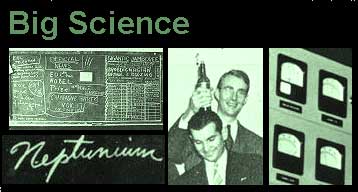

|
|
|
The new experimental devices could do many things that table-top instruments could not. But the Rad Lab's example shows that an obsession with Big Science could come at the cost of research results. As Lawrence and his lieutenants pushed for bigger cyclotrons and higher energies during the 1930s, they learned of important discoveries in nuclear physics made in Europe with less funding, fewer people, smaller devices, and lower energies. Some of the discoveries could have been made in Berkeley, if Lawrence had diverted some attention from improving accelerators to the particles produced and the means of detecting them. In 1932 Cockcroft and Walton in Cambridge, England managed to knock alpha particles from a lithium nucleus with the help of artificially accelerated protons. Two years later, Frédéric Joliot and Irène Joliot-Curie in Paris discovered artificial radioactivity—aluminum that they bombarded with alpha particles was changed to a radioactive isotope. Said Lawrence after the announcement from France, "We have been kicking ourselves that we haven't had the sense to notice that the radiations given off do not stop immediately after turning off the bombarding beam." |
|
|
||
Berkeley theorists, in particular Robert Oppenheimer and his students Robert Serber, Melba Phillips, Wendel Furry, and Sydney Dancoff, helped foster the experimental program of the Rad Lab. Oppenheimer was Lawrence's opposite in many ways. He was a cosmopolitan Jew with interests in transcendental philosophy, a European-trained abstract theorist and an expert in quantum and relativity theory. Lawrence was a midwest Lutheran, a U.S.-trained pragmatic experimentalist, and an expert in electronics and fundraising. Yet the two soon became good friends. The pair represented the rise of American physics, where theory—long neglected by practical-minded Americans—was increasingly allied with experiment. |
|
The Rad Lab program benefited also from frequent visitors who came to learn the art of cyclotronics at its origin. For those who could not come in person, Lawrence sent blueprints and experienced cyclotron builders from his lab. Lawrence's willingness to provide access to his lab and information about its machines helped promote the spread of cyclotrons in the U.S. and abroad. By 1940 there were twenty-two cyclotrons completed or under construction in the U.S., and eleven more overseas. Many of their builders had spent time in Lawrence's lab. |
||
 A Rad Lab chalkboard publicized Lawrence's Nobel Prize. |
|
|||